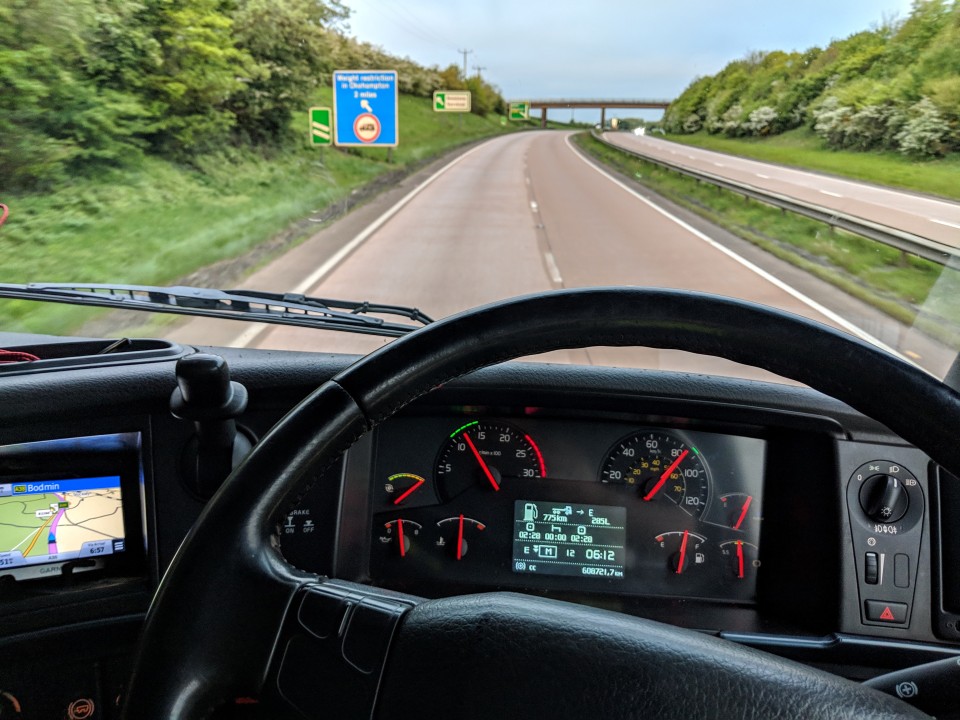
Susie Jones
Regras do tacógrafo facilitadas
Criado: 01/08/2024
•
Atualizado: 08/08/2024
O mundo das regras do tacógrafo pode ser um lugar confuso para o condutor de camiões mais experiente. Muito menos para quem está a entrar no sector. O nosso objetivo é esclarecer alguma dessa confusão.
O que é um tacógrafo e porque é que o temos?
Segundo o dicionário, um tacógrafo é "um dispositivo que é colocado em veículos como camiões e autocarros para registar informações como a velocidade a que o veículo vai, a distância que percorre e o número de pausas que o condutor faz".
O objetivo de um tacógrafo é evitar a fadiga do condutor e garantir que os condutores e os empregadores cumpram as regras. A organização de segurança rodoviária Brake referiu que "quatro em cada dez acidentes relacionados com o cansaço envolvem alguém que conduz um veículo comercial". Por conseguinte, as regras do tacógrafo desempenham um papel vital no objetivo de reduzir este número.
Quando é que é necessário um tacógrafo?
Tem de instalar um tacógrafo se o peso bruto do seu veículo exceder as três toneladas e meia. É importante lembrar que isto inclui rebocar um atrelado. Existem algumas excepções a esta regra:
Se conduzir apenas em estradas públicas
Se o veículo for conduzido por forças armadas, polícia ou bombeiros
Se for uma frota comercial e utilizar veículos com um peso máximo de sete toneladas e meia e a sua viagem for inferior a 100 km da sua base de operações.
Se estiver a transportar mercadorias e o seu veículo for elétrico
Se transportar equipamento ou máquinas para uso do condutor e se a condução do veículo não for a sua atividade principal.
Quais são os diferentes tipos de tacógrafos?
Existem três tipos diferentes de tacógrafos:
Analógicos: Estes tacógrafos tornaram-se obrigatórios na Europa em 1986. Os tacógrafos analógicos utilizam folhas de papel encerado para registar os dados do condutor. Os condutores introduzem manualmente os dados e inserem-nos num aparelho tacográfico.
Digital: Estes foram introduzidos em 2006. São utilizados por mais de um milhão de empresas de transportes e mais de seis milhões de condutores profissionais. Os tacógrafos digitais registam os dados do condutor num dispositivo de armazenamento interno e num cartão de condutor.
Inteligente: A partir de junho de 2019, a União Europeia obrigou as empresas a utilizar tacógrafos inteligentes. Estes registam automaticamente a localização do veículo no início e no fim de cada viagem. Também fornecem actualizações de três em três horas
O que significa cada símbolo do tacógrafo?
Veja o nosso [vídeo] (https://www.youtube.com/watch?v=dgqGmlu9LfM&t=3s) que explica cada símbolo do tacógrafo
Regras de travagem
Para a segurança do condutor do camião e de todos os outros na estrada, as regras de travagem devem ser respeitadas. Descrevemos os pontos-chave.
Tempo de condução:
- Não pode ser superior a quatro horas e meia antes de uma pausa
Pausas:
- Devem ser de pelo menos 45 minutos, a menos que o condutor faça um período de descanso
Período de repouso:
- Durante um período de descanso, não é possível conduzir ou efetuar qualquer outro trabalho
Divisão de pausas:
Uma pausa completa de 45 minutos pode ser dividida por uma pausa de 15 minutos seguida de uma de 30 minutos
As pausas devem ser distribuídas ao longo das quatro horas e meia de condução
De acordo com as regras da UE, se as pausas forem divididas, a segunda pausa tem de ser de, pelo menos, 30 minutos.

Limite diário de condução
O limite diário de condução refere-se ao tempo máximo de condução num dia. O limite máximo é de 9 horas, mas pode ser aumentado para 10 horas. No entanto, isto não pode ser feito mais de duas vezes numa semana fixa. O tempo de condução diário pode ser definido como:
O tempo total acumulado de condução entre o final de um período de repouso diário e o início do período de repouso diário seguinte
O tempo total acumulado de condução entre um período de repouso diário e um período de repouso semanal. .
Limite de condução semanal e quinzenal
Os condutores devem certificar-se de que não excedem os limites máximos de condução semanal e bissemanal.
O limite máximo de condução semanal é de 56 horas (aplicável a uma semana fixa)
Uma semana fixa começa às 00h00 e termina às 24h00 do domingo seguinte
O limite de condução quinzenal é de 90 horas.
Descanso diário
Além disso, deve ser efectuado um descanso diário.
O condutor deve gozar 11 horas contínuas de repouso. Este período pode ser reduzido para nove
Esta redução só pode ocorrer até três vezes entre períodos de descanso semanal
O período de repouso deve ser cumprido no prazo de 24 horas após o termo do último período de repouso diário ou semanal.
O repouso diário pode ser efectuado no veículo; no entanto, são necessárias instalações adequadas para dormir. Se estas instalações não existirem, o condutor deve procurar alojamento. Consulte a nossa página localizações para saber quais as paragens de camiões que oferecem este serviço.
Descanso semanal
Os períodos de descanso semanal devem ser gozados o mais tardar no final de seis períodos consecutivos de 24 horas a contar do final do último descanso semanal.
Os condutores são obrigados a gozar, pelo menos, 45 horas de descanso
Podem gozar um descanso semanal reduzido de, pelo menos, 24 horas
O descanso semanal reduzido deve ser compensado num bloco e, pelo menos, nove horas antes do final da terceira semana.
Embora o descanso reduzido possa ser gozado, é de notar que, em duas semanas consecutivas em que o descanso reduzido tenha sido gozado, uma delas deve ter 45 horas de duração.

Tripulação múltipla
Alguns condutores podem levar outro condutor a bordo. As vantagens incluem maior produtividade, maior quilometragem percorrida e maior tempo de condução.
Ambos os condutores devem gozar nove horas de descanso diário
Este descanso diário deve ser efectuado num período de 30 horas e não de 24.
A primeira hora de multimanning não requer outro condutor. Após uma hora, torna-se obrigatório.
Travessias de ferry ou viagens de comboio
Como acima referido, o período de repouso diário regular de um condutor deve ser de 11 horas contínuas, mas existem algumas excepções a esta regra. Desde que o veículo seja acompanhado pelo condutor, os períodos de repouso diário podem ser interrompidos duas vezes, mas não devem exceder uma hora no total. Por exemplo, o embarque e o desembarque de ferries e comboios.
Se o período de repouso diário regular for interrompido desta forma, o período de repouso acumulado deve ser de, pelo menos, 11 horas ou 12 horas se for fraccionado.
O que é a regra do tacógrafo de um minuto?
A regra do minuto entrou em vigor em outubro de 2011. Refere-se à legislação anterior que estipulava que um minuto com, pelo menos, cinco segundos de condução tinha de ser registado como tempo de condução. No entanto, a UE alterou esta legislação de modo a que a atividade contínua mais longa realizada num minuto seja registada como uma atividade específica.
O que aconteceria se eu não cumprisse as regras do tacógrafo?
O não cumprimento das regras do tacógrafo pode resultar em coimas e, por vezes, em prisão. Geralmente, a sanção depende da gravidade da infração. A maior parte das infracções ao tacógrafo são tratadas com sanções fixas. Os condutores têm até 28 dias para considerar as sanções fixas.
Existem dois tipos de coimas e sanções no Reino Unido.
Coima de nível quatro: O limite máximo é de £2.500; este limite é para cada coima de tacógrafo. No entanto, os casos com várias infracções de nível quatro podem ser objeto de uma coima máxima por infração.
Coima de nível cinco: O limite máximo é de £5.000. No entanto, tal como acontece com as coimas de nível quatro, os casos de infracções múltiplas podem ser objeto da coima máxima.
As regras do tacógrafo podem ser difíceis de compreender. No entanto, o não cumprimento das mesmas pode levar a problemas de segurança e a potenciais coimas. Ao compreender e seguir as regras, as frotas e os condutores podem operar os seus veículos de forma segura e legal. É fundamental ter em atenção que as regras e os regulamentos do tacógrafo podem variar consoante o país.



